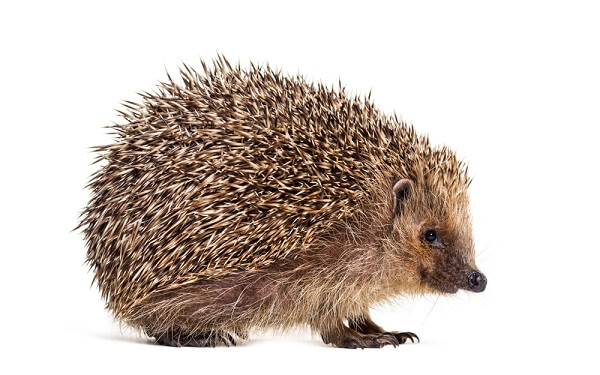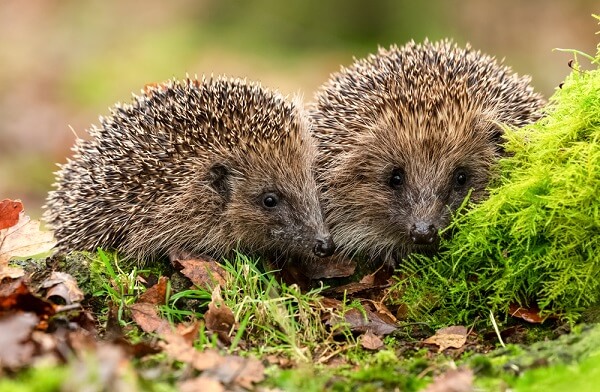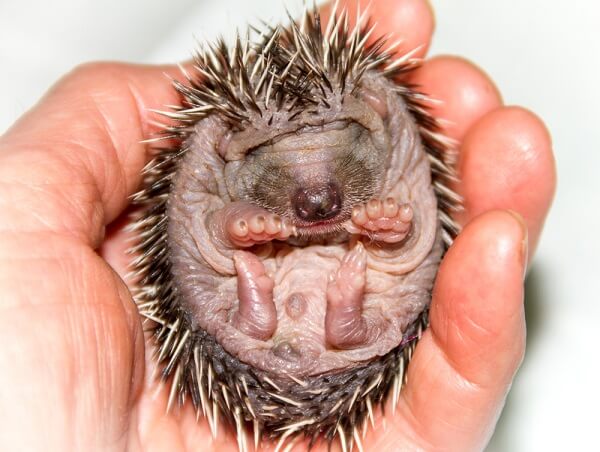
The hedgehog is a small mammal covered in spines, estimated to have evolved approximately 15 million years ago! It is an insectivore that is native to Europe, Asia, and Africa. The hedgehog has also been introduced to New Zealand, where it is considered to be a pest. The hedgehog is a prickly little animal that has spines covering its back. It is brown, black, and white in color. The hedgehog can protect itself by curling into a ball so that only its porcupine-like quills are exposed. The hedgehog’s spines are made from keratin and unlike the porcupine, they are not easily detachable from their body. This nocturnal mammal feasts on bugs and insects and is often found in gardens. Hedgehogs feed on a variety of small animals such as insects, worms, centipedes, snails, mice, frogs, and snakes. They get their name from the foraging technique they use to hunt out their meals. These small mammals root through hedges and the undergrowth in search of food and as it does this it emits small grunts like a pig, hence the name hedgehog. Some hedgehogs are immune to the toxins produced by other animals which enables them to eat venomous snakes, scorpions, and frogs! Hedgehogs are solitary animals and only meet during the breeding season. Hedgehogs breed once a year and produce litters that have between one and eleven young. To attract the female, the male takes part in something called the hedgehog carousel, where it runs in circles around the female. If the female is not convinced that the male is good enough for her, she begins to run in circles, raises her spines, and hisses at him. This process can last for hours. Young hedgehogs are known as hoglets or piglets. They are white in color. Hoglets have quills at birth but unlike the adult’s quills, these are soft and much more flexible. During birth, the hoglets quills are covered by skin that is filled with fluid to prevent them from hurting the mother. It takes about a day for the skin to shrink and the white quills to appear. The babies remain with their mothers for only four to seven weeks before they go off into the world alone. During this time the females protect their young from predators, which include other male hedgehogs that are known to prey upon the young of their own species. Hedgehogs mature between nine and 11 months of age. There are 17 recognized species of hedgehog that belong to five different genera. Hedgehogs are native to Europe, Asia, and Africa, although they have been introduced to New Zealand. There are no hedgehogs found in the Americas. Let’s take a look at some of the different species. Though Sonic the Hedgehog may seem cool, actual hedgehogs are much cooler! Hedgehogs are prickly little mammals that eat mostly insects and because of this, they are popular with gardeners. They have several biological adaptations that have helped them to inhabit a wide range of environments and climates. Let’s take a closer look! Hedgehogs are amazing little mammals that have some tricks that help them avoid predators. Hedgehogs are immune to certain poisonous plants. When they eat these plants they make frothy saliva in their mouth that they then lick all over their spines. This covers them in the plant’s poison! Scientists believe this tactic may help to hide their scent from predators or give predators a nasty shock should they attack! While this may seem strange, this is actually a very common trick that many creatures use to defend themselves. Poison-dart frogs get toxins from the ants they eat that protect them from predators. Nudibranchs transfer the stinging cells of the corals they eat to the surface of their skin, where the stinging cells provide protection. Even Monarch butterflies are poisonous to birds because of the toxins they pick up from the plants they feed on as caterpillars! Sometimes called a pincushion on legs, a hedgehog protects itself from predators by using its prickly outer layer as protective armor. A hedgehog has 3,000 to 5,000 quills on its back that it uses to deter potential predators from eating it for dinner. When a hedgehog feels threatened it raises its quills upright, making a crisscross pattern which makes its body sharp and unappealing to suspecting predators. The hedgehog has extra skin and strong stomach and back muscles that it uses to curl into a complete ball, tucking its head, legs, and tails in. This ball of spikes protects its soft stomach and is hard for predators to open. Interestingly, these spines are completely hollow and can be raised independently! Porcupines also have spines made from keratin that they use to protect themselves from predators. Despite this similarity, hedgehogs and porcupines are not closely related. Porcupines are rodents and closely related to rats where hedgehogs are more closely related to shrews. This is a case of convergent evolution – a biological term that describes when two unrelated species develop similar traits because they have had similar selective pressures. Other convergent traits include wings in bats and birds, fins in fish and whales, and complex eyes in mammals and octopuses! Hedgehogs go into a state of sustained torpor, or inactivity during the winter when food is scarce. Hedgehogs enter this state of dormancy known as hibernation. During hibernation, the animals enter a state of minimal activity and metabolism depression. Their body temperature is decreased to save energy as most of the calories that warm-blooded animals, like hedgehogs, burn go into maintaining their basal metabolic rate. Animals enter hibernation to save energy when food becomes scarce. Usually, this is associated with cold climates, but it also happens in climates that experience really high temperatures, and in this case, it is known as estivation.
Kingdom
Animalia
Phylum
Chordata
Class
Mammalia
Order
Erinaceomorpha
Family
Erinaceidae
Genus
5 different genera
Species
17 different species
Length
Head and body: 4 to 12 inches (10 to 30 cm); tail: 1 to 2 inches (2.5 – 5 cm)
Weight
2.2-4.4 lbs (1-2kg)
Lifespan
3 – 6 years
Social Structure
Solitary
Status
Least concern
Habitat
Thick vegetation and woodland
Average litter size
5
Main food item
Earthworms, woodlice, insects, and toads.
Main predators
Owls, dogs, and foxes.
The Basics


Hedgehog Species
Fun Facts about the Hedgehog!
Self-Anointing
Prickly Pincushion

Hibernation, and Estivation
